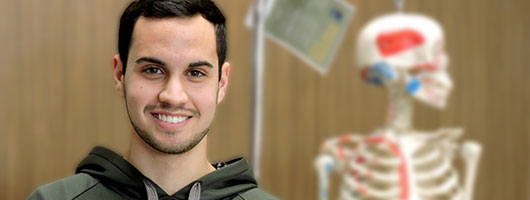 Pictured | Branden Pratt | Radiography | South Bend, Indiana (hometown)
Pictured | Branden Pratt | Radiography | South Bend, Indiana (hometown)
About the Radiography Program Professional Program
Radiography is an art and science which involves the medical imaging of patients to produce a radiograph for the diagnosis of disease. The main goal of the radiographer is to produce the highest quality diagnostic image using ALARA (As-Low-As-Reasonably-Achievable) Radiation Standards with a minimum amount of patient discomfort.
A radiographer's responsibilities involve multiple areas of expertise—trauma, surgery, fluoroscopy, portable/mobiles, and general diagnostic radiography. Constant growth in the field has created many new and exciting careers in Ultrasound (US), Pet Scan, Computerized Tomography (CT), Magnetic Resonance Imaging (MRI), cardiovascular/interventional radiography, radiation therapy, and nuclear medicine.
The radiographer functions in many different roles within the health profession. They may work independently or interact with other members of the health care team such as radiologists, surgeons, emergency medicine physicians, hospitalists, cardiologists, and nurses. Radiographers are employed in hospitals and out-patient facilities such as occupational and urgent care centers, clinics, imaging centers, and doctors’ offices.
Academic Advising
College policy on advising requires that students meet with their academic advisors at least once each year, and in some departments, prior to each semester’s to enrollment. Advising holds are placed on all Dwyer College of Health Sciences students prior to advance registration and are released following advising appointments. Students with a declared major are advised in their academic units. To determine who your advisor is and how to contact them, see One.IU.
Degree Requirements (81 cr.)
Degree Map >>
Students receiving the Associate of Science in Radiography must complete 81 total credit hours, in the order specified by faculty, including:
- IU South Bend Vera Z. Dwyer College of Health Sciences General Education Curriculum (6 cr.)
- Fundamental Literacies | ENG-W 131 Reading, Writing, and Inquiry I
- Oral Communication | SPCH-S 121 Public Speaking
- Biomedical Sciences Requirements (11 cr.)
- Major and Elective Requirements (59 cr.)
- Additional Degree Requirements (5 cr.)
- Courses in the Professional Program are sequential and must be taken in the order specified by the program faculty.
- Total credit hours do not include introductory collegiate classes nor any course mandated by placement exam scores, admission status, and prerequisite criteria.
Major and Elective Requirements (59 cr.)
All courses are 3 credit hours, unless otherwise designated.
- AHLT-R 100 Orientation to Radiographic Technology
- AHLT-R 101 Radiographic Procedures I
- AHLT-R 102 Principles of Radiography 1
- AHLT-R 103 Introduction to Clinical Radiography (2 cr.)
- AHLT-R 180 Radiographic Procedures Laboratory (1 cr.) (Pending final approval)
- AHLT-R 181 Clinical Experience in Radiography
- AHLT-R 182 Clinical Experience–Radiography
- AHLT-R 200 Pathology (2 cr.)
- AHLT-R 201 Radiographic Procedures II
- AHLT-R 202 Principles of Radiography 2
- AHLT-R 205 Radiographic Procedures III
- AHLT-R 207 Seminar (2 cr.)
- AHLT-R 208 Topics in Radiography (2 cr.)
- AHLT-R 222 Principles of Radiography 3
- AHLT-R 250 Physics Applied to Radiology
- AHLT-R 260 Radiobiology and Protection
- AHLT-R 281 Clinical Experience-Radiography (4 cr.)
- AHLT-R 282 Clinical Experience IV (4 cr.)
- AHLT-R 283 Clinical Experience V (4 cr.)
- AHLT-R 290 Comprehensive Experience (4 cr.)
Additional Degree Requirements (5 cr.)
- AHLT-R 185 Medical Terminology (2 cr.)
- MATH-M 107 College Algebra
Photo credit | Teresa Sheppard